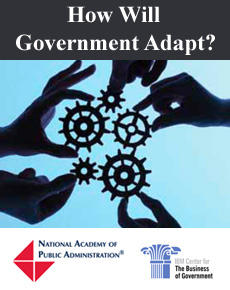
How Will Government Adapt?: Sharing Across Stovepipes Is the New Normal

Fiscal sustainability continues to drive the impetus to reduce backroom costs, more from necessity than from a desire for government organizations to dramatically change the status quo. OMB is already moving aggressively in this direction through its Federal IT Shared Services Strategy (“Shared First”) and the issuance of its Memorandum to agencies in 2013, Improving Financial Systems Through Shared Services (M-13-08). This panel explored how agencies can successfully manage what represents transformational change that cuts across organizational boundaries to move to shared services and break down stovepipes. This is the fourth blog post in a series that sums up highlights of selected sessions held as part of the annual meeting in mid-November of the National Academy of Pubic Administration. Panelists The Honorable David A. Mader, Controller, Office of Federal Financial Management, U.S. Office of Management and Budget Elizabeth Angerman, Director, Office of Financial Innovation and Transformation U.S. Department of Treasury The Honorable Chip Fulghum, Chief Financial Officer, U.S. Department of Homeland Security The Honorable Brad Huther, Chief Financial Officer, U.S. Department of Housing and Urban Development Highlights Successfully implementing a shared services initiative isn’t primarily about getting the technology or processes “right,” but about having the will to do it, committed leadership, and culture change. OMB’s guidance to move to shared financial management services creates a new dynamic for action in agencies. Most of the previous financial management-related shared services initiatives focused on creating these services for smaller agencies. Now the emphasis is on migrating the 24 CFO Act Departments and Agencies to shared services platforms. The long-term vision is to move agencies to one of a group of approved shared services financial management centers. Departments and agencies competed to be the selected providers of one of these four shared financial services. OMB eliminated from consideration those applications from agencies who offered to deliver shared services only within their own Department. That resulted in four cross-agency financial management shared services providers being approved: the Departments of Agriculture, Treasury, Interior, and Transportation. With the designation of these four financial management shared services providers, other departments and agencies are now focusing on governance issues for these centers, for example: what is the weight of my vote on the governing board for my center? Who manages the overall market place to ensure a level playing field? And, how will service level agreements (SLAs) be structured and monitored? After all, the SLAs define customer-provider relationships; true “shared services” arrangements are not just a consolidation or centralization of services. Not all departments and agencies are ready to move to one of the four centers. Some are creating their own, interim, shared services within their own department and will determine their long-term migration to a governmentwide center down the road. For example, Brad Huther indicated that the Department of Housing and Urban Development is in the early stages of moving to the use of shared financial services within the department. He is relatively new in his role as HUD’s assistant secretary/CFO and observed that HUD is among the most siloed Departments he’s seen in his long federal career. He said that each bureau has its own accounting system and their own accounting standards, and it would be almost impossible to move to a governmentwide platform from where they are now. For Huther, Step One is rationalizing the business imperative to move these bureaus to a common platform within the department. Similarly, Chip Fulgham, CFO at the Department of Homeland Security, said that his department will also be transitioning some of its components to a shared financial management environment in coming months, within the department. OMB’s David Mader said the goal is to bring shared services initiatives together in the next six months and to have the right funding systems to make the initiatives work. He said that OMB is open to exploring what optimal designs look like. An assessment of the maturity levels of the different ongoing shared services efforts is underway. Mader sees a need to ensure more system/backend standardization as a step toward a level playing field for competition between the different shared services centers. This will be necessary, he believes, to ensure a long-term sustainability of the shared services concept. Visit the landing page of this initiative where you can learn of future blog post topics and follow previous conversations.



